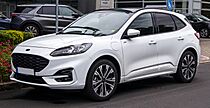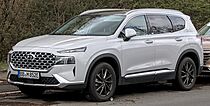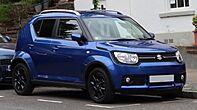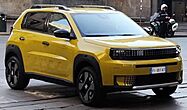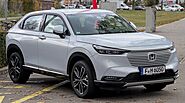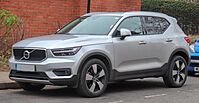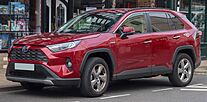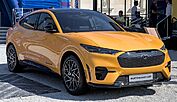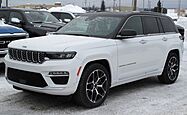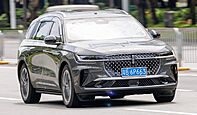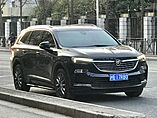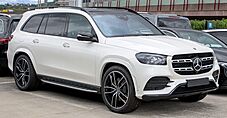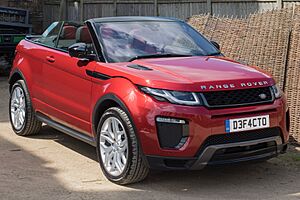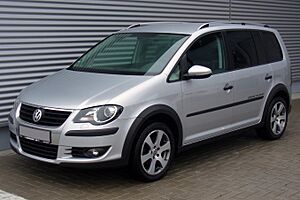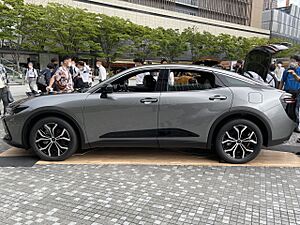Crossover (automobile) facts for kids
A crossover (also called a crossover SUV or CUV) is a type of car that looks like a SUV but is built more like a regular passenger car. Think of it as a mix between a car and an SUV!
Traditional SUVs are built on a strong frame, like a pickup truck. But crossovers are built on a "unibody" frame, which is the same kind of frame used for regular cars. This makes them feel more like driving a car.
The word "crossover" first came from North America. It was used for vehicles that blended features from two different types of cars. Over time, it mostly came to mean SUVs that are built on a car-like frame. People sometimes call them "car-like SUVs" or "car-based SUVs." Even though they are different, the word "SUV" is often used for both crossovers and traditional SUVs.
Compared to traditional SUVs, crossovers are usually not as good for driving off-road or pulling very heavy loads. However, they are better in other ways. They often get better gas mileage and are easier to handle (drive and steer).
Compared to regular cars like sedans or hatchbacks, crossovers offer more space inside. They also give you a higher driving position, which means you can see more of the road.
The 1977 Lada Niva was one of the first cars that combined off-road ability with a car-like body. It was a very early example of what we now call a crossover. The 1979 AMC Eagle was the first one in the US. Later, the Toyota RAV4, first made in 1994, really helped make the modern crossover popular.
In the US, crossovers have become super popular. In 2000, less than 4% of cars sold were crossovers. By 2018, that number jumped to almost 40%!
Contents
What is a Crossover?
The main difference between a crossover SUV and a traditional SUV is how they are built. A crossover uses a "unibody" platform. This means the body and frame are one piece, like most cars. A traditional SUV uses a "body-on-frame" platform. This means the body sits on top of a separate, strong frame, like a truck.
However, in real life, these definitions can get a bit blurry. Many unibody vehicles are still called SUVs. The word "crossover" is also quite new. Older unibody SUVs, like the 1984 Jeep Cherokee, are usually just called SUVs. Because of this, "SUV" is often used as a general term for both types of vehicles.
Outside of North America, people often don't make a big difference between crossovers and body-on-frame SUVs. They just call both of them SUVs. In some places, crossovers are even classified as light trucks, just like traditional SUVs and pickup trucks.
In the United Kingdom, a crossover is sometimes seen as a hatchback car that has been lifted higher off the ground and given SUV-like looks.
How Crossovers Drive
Crossovers drive a lot like regular passenger cars. They offer a comfortable ride and good performance. They also give you more space for passengers and cargo. Plus, they usually don't use much more fuel or cost a lot more to run than a regular car.
For example, in 2018, the top-selling crossovers in the US (like the Toyota RAV4, Honda CR-V, and Nissan Rogue) used about 10% more fuel than popular mid-size sedans. But they offered almost 1.5 times more cargo space! Also, the average mid-size crossover cost only about 5% more than a mid-size car.
Compared to SUVs built on truck frames, crossovers are usually more comfortable inside. They have a smoother ride, better gas mileage, and cost less to make. However, they are not as good for serious off-road driving or towing very heavy things. Many crossovers don't even have all-wheel drive or four-wheel drive. This makes some people wonder if they should really be called "sports utility vehicles." Some even call them "pseudo-SUVs" (meaning "fake" SUVs).
History of Crossovers
The AMC Eagle, first made in 1979, is often seen as the first true crossover car. It was built on a car platform but had four-wheel drive and was taller than a regular car. Another early idea was the 1963 Studebaker Wagonaire, which was a station wagon with a sliding roof. Some people called it the "first crossover" because it mixed different vehicle types.
The 1977 Matra Rancho is also considered an early crossover. It was marketed as a "lifestyle" vehicle, but it didn't have four-wheel drive. In 1981, American Motors Corporation (AMC) also made smaller four-wheel-drive cars like the "Eagle SX/4." These cars were comfortable and good in bad weather.
The first-generation Toyota RAV4, released in 1994, really helped make the modern crossover popular. The RAV4 used a modified platform from the Toyota Corolla car. When it came out, Toyota in Japan called it a "4x4 vehicle," while in the US, they called it a "new concept SUV." By the early 2000s, Toyota was a leader in making car-based SUVs in North America, with models like the Toyota Highlander and Lexus RX.
Crossovers became very popular in North America during the 2000s. This was partly because rules for fuel efficiency for light trucks changed, and gas prices went up. Traditional SUVs started to lose sales to crossovers. By 2006, crossovers made up more than half of the entire SUV market in the US. Crossovers have also become very popular in Europe since the early 2010s.
In early 2023, the Tesla Model Y crossover became the best-selling car in the whole world!
Crossover Sizes
Crossovers come in different sizes, depending on the market. There isn't one official way to sort them, so sometimes a car's size category can be a bit unclear. Things like length, width, where it fits in a brand's lineup, and how much space it has inside can help decide its size.
Crossover City Car (A-segment)
Crossover city cars are the smallest crossovers. They are usually built on the same platform as a city car (A-segment).
This is a newer type of car. The Fiat Panda Cross was one of the first, and the Suzuki Ignis helped make this type of car more well-known. These cars often look like hatchbacks.
Since the late 2010s, this group of cars has gotten a lot more attention. Some examples from 2023 include the Toyota Aygo X, Hyundai Casper, Suzuki Ignis, and Fiat Panda Cross.
Subcompact Crossover SUV (B-segment)
Subcompact crossover SUVs are also called B-segment crossovers or small SUVs. They are usually based on the platform of a subcompact car. Some fancier subcompact crossovers might use a compact car (C-segment) platform.
The name for this size can change depending on where you are. In some places, they might be called "compact crossover" or "compact SUV" instead.
This type of crossover is very popular in Europe, India, and Brazil. In 2018, they made up a huge part of all SUV sales in those regions. The Honda HR-V was the best-selling car in this group in 2019, with over 622,000 sold worldwide.
Compact Crossover SUV (C-segment)
A compact crossover SUV is usually built on the platform of a compact car (C-segment). Some might use a mid-size car (D-segment) or even a subcompact (B-segment) platform. Most compact crossovers have two rows of seats, but some have three.
Like other sizes, the name for this group can be different in various places. Outside North America, they might be called "mid-size crossover" or "mid-size SUV."
The 1980 AMC Eagle was the first compact crossover. It had four-wheel drive, which was very rare for regular cars back then. Later models include the 1994 Toyota RAV4, 1995 Honda CR-V, and 2001 Ford Escape.
Between 2005 and 2010, compact crossovers became much more popular in the US. By 2014, they even sold more than mid-size sedans in the United States for the first time!
This group is now the most popular car type in many places. In 2019, almost 1 out of every 4 cars (24.2%) sold in the United States was a compact crossover. The Toyota RAV4 was the best-selling compact crossover in 2019, with over 961,000 sold globally.
In late 2020, new electric compact crossovers like the Volkswagen ID.4 and Ford Mustang Mach-E came out.
Mid-size Crossover SUV (D/E-segment)
Mid-size crossover SUVs are bigger than compact crossovers but smaller than full-size ones. They are usually based on the platform of a mid-size car. Some might use a full-size car or even a compact platform. Some mid-size crossovers have three rows of seats, while others have two. This allows brands to offer different options, like the Honda Pilot (three rows) and its two-row version, the Honda Passport.
The first mid-size crossovers were the Toyota Highlander and Pontiac Aztek, both introduced in 2000.
This size is most popular in North America and China, where people often prefer larger vehicles. It makes up about 15.8% of the total car market in the United States. The Toyota Highlander was the best-selling car in this group in 2018, with over 387,000 sold worldwide.
Full-size Crossover SUV
Full-size crossover SUVs are the biggest crossovers. They almost always have three rows of seats. Early full-size crossovers included the Ford Freestyle, GMC Acadia, and Buick Enclave. Older full-size SUVs were usually built on a body-on-frame chassis.
Full-size crossovers are not always based on full-size cars. For example, the Mercedes-Benz GLS uses the same architecture as the mid-size Mercedes-Benz GLE, not the full-size Mercedes-Benz S-Class sedan. However, the GLS is still seen as the crossover version of the S-Class.
Crossover Body Styles
Three-door Crossover
While many traditional SUVs have three doors (including the back hatch), crossovers with three doors are not very common. This is because cars with two or three doors in general are becoming less popular.
Coupe Crossover
Crossover SUVs with a sloped roofline at the back are sometimes called "coupe crossover SUVs" or "coupe SUVs." Even though the word "coupe" usually means a two-door car with a sloped roof, most coupe crossovers have five doors. The sloped roof is meant to make them look more stylish than regular crossovers. However, some people think this design is less attractive. This style has also been criticized for being more expensive and less practical than normal crossovers. The BMW X6 is known as the first coupe crossover.
Convertible Crossover
The first crossover convertible was the AMC Eagle Sundancer, sold in 1981 and 1982. It was a special version of the all-wheel-drive two-door sedan.
Several convertible crossover SUVs have been made, like the Toyota RAV4 convertible (1998-1999). Other examples include the Nissan Murano CrossCabriolet, Range Rover Evoque Convertible, and Volkswagen T-Roc Cabriolet.
Journalists and car fans often criticized this type of car. They didn't like the design or the high price. Some also questioned why they existed, as they lost the practicality that crossovers usually offer, having only two doors and little space for luggage.
Crossover-Styled Cars
Many car makers have used the popularity of SUVs to create versions of their station wagons, hatchbacks, or MPVs (minivans) that look like crossovers. They do this by raising the car higher off the ground and adding rugged-looking parts. These parts include black plastic wheel arch extensions, body cladding, skid plates (to protect the underside), and roof rails. Because they are higher off the ground, these vehicles might be marketed as being better for light off-road driving. Some might even have all-wheel drive. This strategy helps car makers make their models seem more upscale or fill a gap in their crossover lineup. These cars are sometimes called "pseudo-crossovers."
Crossover Station Wagon

Many car makers have made "off-road" versions of their station wagons. These wagons have more cargo space and are very practical. They are marketed as being better for light off-road conditions or bad weather because they are higher off the ground. This makes them a "crossover" between a station wagon and an SUV. In North America, some car makers sell station wagons with crossover styling because regular wagons are not as popular there. The Subaru Outback is a very popular example.
An early model was the Subaru Legacy Outback (later just Outback) in 1994. Subaru didn't have an SUV at the time. So, they took their Legacy wagon, added two-tone paint, body cladding, and lifted the suspension. They marketed it as a capable and fuel-efficient option compared to bigger, truck-based SUVs. Another example is the Volvo V70 XC, first made in 1999. Audi has also made Allroad versions of their station wagons since 1999.
Crossover Hatchback
Crossover-styled versions of hatchbacks or city cars were made to be an alternative or addition to subcompact crossover SUVs. Most crossover-styled hatchbacks do not have all-wheel drive. Early examples include the 1983 Fiat Panda 4x4 and the 1994 Outback Sport.
In the 2000s, the Volkswagen CrossPolo started the modern trend of crossover-style hatchbacks. It was marketed as an SUV-like "lifestyle" vehicle. The Dacia/Renault Sandero Stepway, a crossover-style version of the Sandero launched in 2009, is a good example. It makes up 65% of all Sandero sales.
Crossover MPV/Minivan
One of the first MPVs (minivans) with a crossover-style version was the Renault Scénic#Scénic RX4, introduced in 2000. It was taller, had rugged body cladding, a spare wheel on the back door, and optional part-time four-wheel drive. Another example is the Volkswagen CrossTouran, launched in 2006. It was a lifted version of the Touran and marketed as a "lifestyle" vehicle.
Because crossovers became so popular, many car makers started designing MPVs from scratch with crossover features. They often market these as "crossover MPVs," like the 5th generation of Renault Espace.
Crossover Sedan
The innovative AMC Eagle from 1979 was a unibody, all-wheel-drive car that was available as a two-door and four-door sedan.
Some examples of sedans with crossover features are the Subaru Legacy SUS (which stands for "Sport Utility Sedan"), Volvo S60 Cross Country, Polestar 2, and Toyota Crown Crossover.
Crossover Sales
Europe
Since the early 2010s, more and more crossovers have been sold in Europe. By 2017, sales of compact and mid-sized crossovers continued to grow quickly. Data from JATO Dynamics showed that SUVs (mostly crossovers) made up almost 40% of the European car market in 2019. Crossovers were a big reason for the growth in car sales and profits.
United States
Crossover sales in the US jumped by 30% between 2003 and 2005. By 2006, they were very visible in the US market, making up more than half of all SUV sales. Sales grew another 16% in 2007. In 2013, the Audi Q5 became Audi's second best-selling car in the United States, right after the Audi A4 sedan. Between the late 1990s and 2012, about half of Lexus's sales came from its SUVs.
American car makers were a bit slow at first to stop focusing on truck-based SUVs. Foreign car makers developed crossovers for the US market as an alternative to station wagons, which weren't very popular there. But by the early 2000s, American car makers had caught up.
China
The crossover market has been the fastest-growing part of China's passenger car market since the early 2010s. From 2011 to 2021, the share of crossovers in China's passenger vehicle sales grew by almost 35 percentage points, going from about 13% in 2011 to nearly 48% in 2021. A 2017 survey showed that Chinese buyers were willing to pay more for SUVs.
By 2023, several crossover models were among the best-selling cars overall in China. The Tesla Model Y was the best-selling car across all types. Other popular crossovers included the BYD Song Plus and Yuan Plus. In 2023, Land Rover also saw big growth in China. Sales of the Range Rover and Range Rover Sport went up by 31%, and sales of the Land Rover Discovery grew by 14%.
See also
- Car classification
- List of sport utility vehicles
- Mini SUV
- Minivan
- Recreational vehicle


